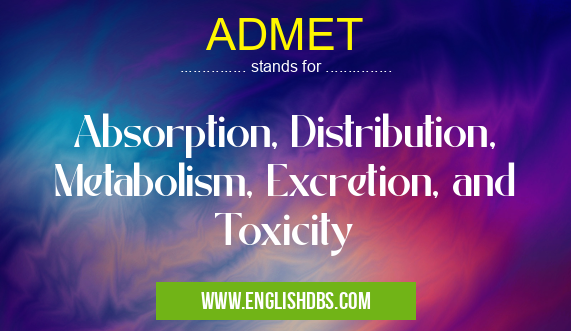What does ADMET mean in PHYSIOLOGY
ADMET stands for Absorption, Distribution, Metabolism, Excretion, and Toxicity of a drug. It is part of pharmacokinetics which is the study of how drugs move throughout the body and are processed by the organs. The term ADMET refers to how a drug will be absorbed into the bloodstream, distributed throughout the body’s tissues, metabolized in various organs, excreted from the body, and eventually cause toxic effects if given in too high of doses. It is important to understand these processes so that appropriate dosing can be determined which will ensure maximum efficacy while minimizing side effects.

ADMET meaning in Physiology in Medical
ADMET mostly used in an acronym Physiology in Category Medical that means Absorption, Distribution, Metabolism, Excretion, and Toxicity
Shorthand: ADMET,
Full Form: Absorption, Distribution, Metabolism, Excretion, and Toxicity
For more information of "Absorption, Distribution, Metabolism, Excretion, and Toxicity", see the section below.
» Medical » Physiology
Absorption
Absorption is the process by which a drug enters into systemic circulation after being administered. Drugs can be administered through various routes such as oral, intravenous (IV), intramuscular (IM), or transdermal. After administration they are then processed by enzymes in the gastrointestinal tract and finally enter into systemic circulation where they can exert their therapeutic effect on target organs or tissues within the body.
Distribution
Once a drug has been absorbed it then has to be distributed throughout various tissues in order to reach its target site and produce its therapeutic effects. This process is governed by several factors such as solubility of the drug in water or fat-based molecules present in tissue beds or organs, protein binding of drugs in plasma proteins as well as blood flow to certain tissues which transport molecules across cell membranes.
Metabolism
Metabolism involves further processing of drugs inside cells or other systems within the human body so as to make them more water soluble for easy elimination from the body. During this process enzymes break down active substances into metabolites which may or may not have any therapeutic effect on target tissue or organ systems but often contributes towards side-effects seen with certain medications.
Excretion
Excretion is simply referred to as elimination from the body primarily through renal clearance via urine when it comes to drugs commonly used in clinical practice today. Other methods include hepatic clearance via bile secretions from liver cells as well as exhalation and sweat glands depending on what kind of substance it is that needs to be eliminated.
Toxicity
Toxicity refers to an adverse effect that arises due to an accumulation of a particular molecule within an organism either due to excessive dosage or extended exposure over time leading up to it becoming toxic for an individual's specific physiology.
Essential Questions and Answers on Absorption, Distribution, Metabolism, Excretion, and Toxicity in "MEDICAL»PHYSIOLOGY"
What is ADMET?
ADMET stands for Absorption, Distribution, Metabolism, Excretion, and Toxicity. These terms represent the five major factors influencing the efficacy of a drug as it passes through the body. It is important to understand how drugs interact with the body in order to develop safe and effective medications.
What does absorption mean?
Absorption refers to the process by which a drug enters into circulation through either direct or indirect pathways within the body. This process determines how much of a drug reaches its target site, thereby determining effectiveness.
What is distribution?
Once a drug has been absorbed into circulation, it needs to be transported throughout the body so that it can reach its intended target site. The distribution step involves the movement of a drug from its point of absorption to all other areas of the body that may be affected by its effects.
How is metabolism involved in ADMET?
Metabolism refers to the breakdown of drugs by enzymes and other proteins produced by organs such as the liver or kidneys. This step ensures that drugs are broken down into their simplest form so that they can be filtered out of circulation and safely excreted from the body.
How does excretion relate to ADMET?
Excretion refers to the elimination of drugs from the body once they have been metabolized and filtered out from circulation. This can take place via different routes including urine, faeces, sweat, saliva, and even exhaled air.
What role does toxicity play in ADMET?
Toxicity refers to any negative effects associated with drugs that are potentially harmful to health when taken at high doses or for extended periods of time. It is important to understand how toxic substances interact with other components within an organism’s system in order reduce any potential adverse reactions or interactions.
How is drug efficacy determined?
Drug efficacy represents how well a specific medication will work under conditions as prescribed by a physician. In order for a medication to be deemed effective, it must adequately fulfill all steps outlined in ADMET first; absorption, distribution, metabolism, excretion, and toxicity must each be considered.
Is there a risk associated with taking drugs?
Yes – like any type of medication or therapy there are risks associated with taking them. To reduce these risks it's important for individuals to understand what they are taking in terms of dosage, frequency and potential side-effects. Additionally consulting your healthcare professional prior to taking any medications should also help limit risk.
Are all medications monitored through ADMET processes?
Yes - All prescription medicines must go through an extensive ADMET evaluation before being approved for use by humans due safety considerations identified during this evaluation period.
Final Words:
ADMET is an important component of pharmacology and covers many important aspects related to drug use such as absorption, distribution, metabolism, excretion and toxicity of various medications used for treatment today. Understanding these different processes helps clinicians determine proper dosing regimens for patient safety and optimal efficacy outcomes.
